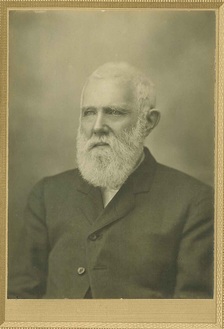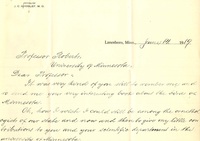As I was lying in bed, staring at the ceiling, holding a wet washcloth to my forehead in an attempt to reduce my fever, I remembered a series of letters I read last week from the correspondence files of the Bell Museum of Natural History. I was on day three of a bout of the flu, and the acute awareness of health, or the loss of health that I was experiencing, is what spurred my memory of the letters.
 From an early date, Thomas Sadler Roberts corresponded with individuals throughout the state in order to record seasonal bird observations. J.C. Hvoslef, a medical doctor from Lanesboro, was a regular correspondent who frequently reported the birds that he encountered in southeastern Minnesota. As the years passed, however, it is evident through Hvoslef’s letters that his diminishing health was taking a toll on not only his ability to continue to keep bird records, but also upon his vitality of life.
From an early date, Thomas Sadler Roberts corresponded with individuals throughout the state in order to record seasonal bird observations. J.C. Hvoslef, a medical doctor from Lanesboro, was a regular correspondent who frequently reported the birds that he encountered in southeastern Minnesota. As the years passed, however, it is evident through Hvoslef’s letters that his diminishing health was taking a toll on not only his ability to continue to keep bird records, but also upon his vitality of life.
Hvoslef first mentioned his health in an April 1917 letter, “In the meantime, my days as a field naturalist are gone forever, never to return. A cataract of the left eye is sufficient to settle my doom.”
Five months later, in December of 1917, Hvoslef wrote to Roberts with a more detailed description of his condition:
“I am sorry to say that I have been unable, despite my ardent longings for nature’s wonders, to continue my field observations of the birds as in former days. The barbed wire fences, the prohibition against shooting and angina pectoris in conjunction with the increasing blindness of my left eye have almost completely intersected my gratifying all interests of that kind.”
 One of Hvoslef’s final letters to Roberts, from June 1919, reveals Hvoslef’s longing for the days prior to succumbing to illness wherein he could enjoy and fully experience nature:
One of Hvoslef’s final letters to Roberts, from June 1919, reveals Hvoslef’s longing for the days prior to succumbing to illness wherein he could enjoy and fully experience nature:
“Oh, how I wish I could still be among the ornithologists of our state and now and then to give my little contributions to you and your scientific department in the university of Minnesota.
But fate willed it otherwise. I was unexpectedly seized with a heart disease, the nature of which I do not till this time understand… More likely the disease seems to me to be of rheumatic nature although there are objections even to that diagnosis. That the myocardium and its many intricate parts are liable to numerous and mysterious ailments we all know – but it is useless to dwell on those unsolved puzzles. On even slight muscular exertions, on walking for instance, I am seized with very severe pain… and along the left arm (angina pectoris) and this will on continued use of the muscles bring on an uncontrollable dizziness that may even make me fall. Under these circumstances my business as a doctor has been made almost impossible, and no less have I been prevented from going on with the work of a naturalist. I have had entirely to give up my tramps through the woods, and those lonely, pathless by places where I frequently made my most lucky observations are never any more disturbed by me.
That this should last much longer, I do not think possible, nor do I wish it, to be sure. And yet, I may still have to live for some time. If that should happen, I shall indeed never forget those happy hours when undisturbed, in the stillness of nature I could enjoy the sight of the pretty birds and listen to their chattering of songs.“
No matter how severe an illness, when we’ve lost our health, we greatly desire for it to be restored in order to again enjoy the things which make life worth living. On that note, from a recent personal experience, go get a flu shot if you haven’t already this season. Get a flu shot so you can continue to enjoy the happy hours and so that you don’t have to suffer through the sick ones…
**Johan Hvoslef was born in Norway in 1839. He graduated from the University of Norway and after coming to America in 1872, attended the Rush Medical College of Chicago. In 1876 he established a medical practice in Lanseboro, MN. Hvoslof passed away in 1920. In 1921, Hvoslef’s widow, Karen Anderson Hvoslef, donated her husband’s nature study journals to the Museum of Natural History. Over 50 volumes document nearly four decades of natural history observances in southeastern Minnesota.